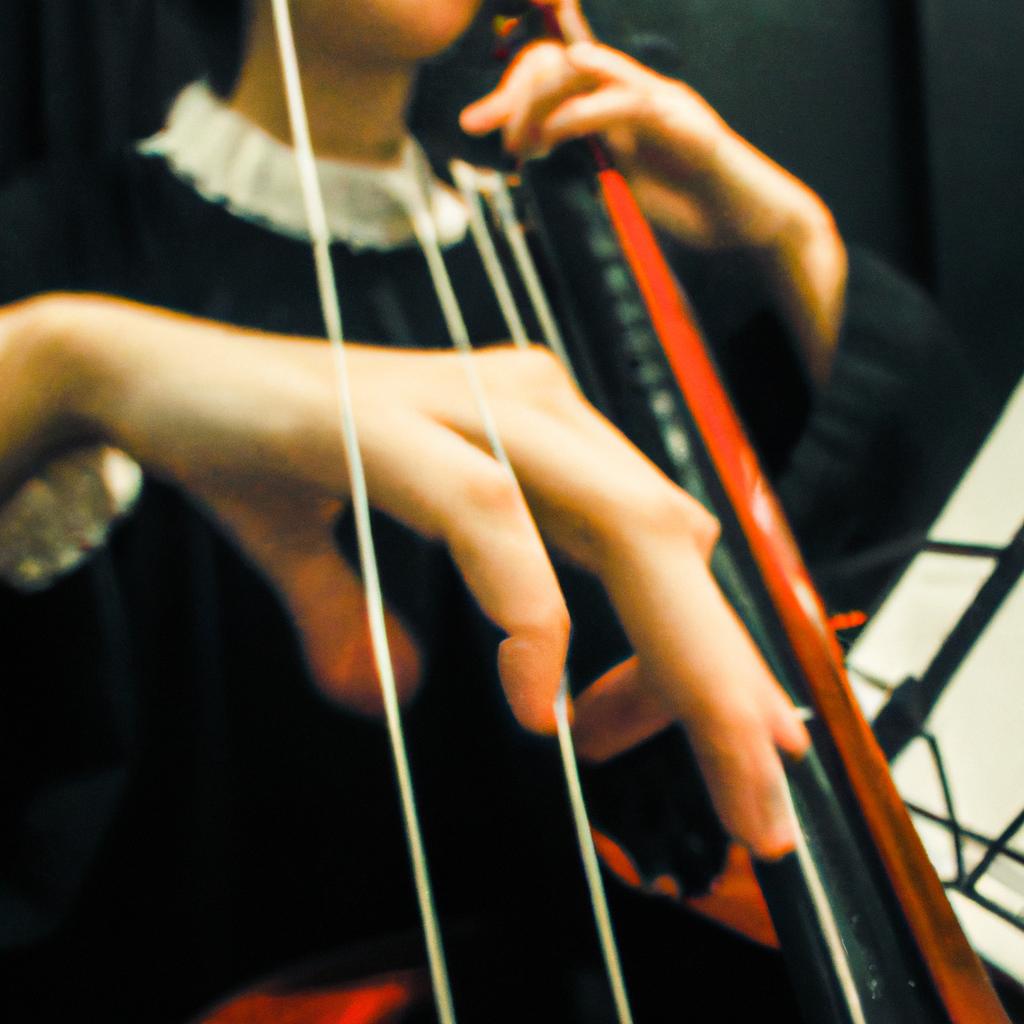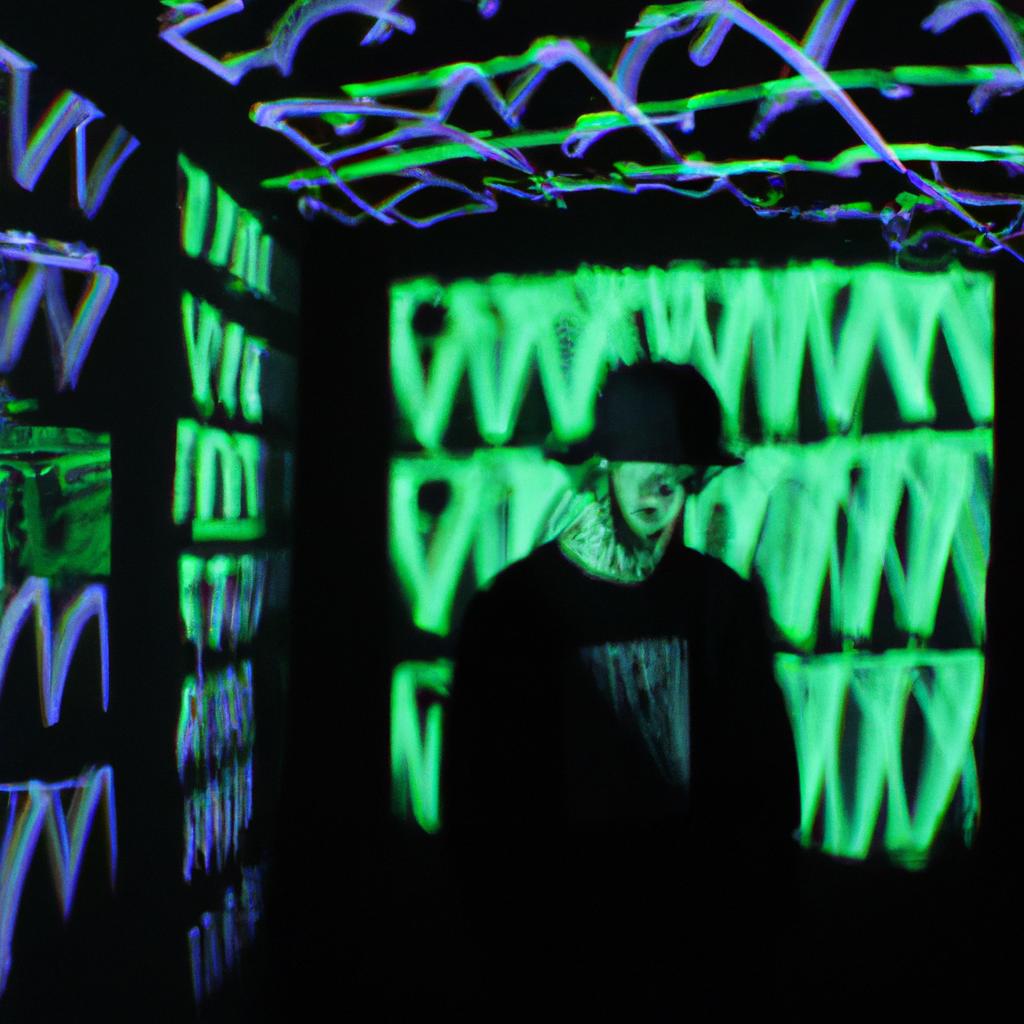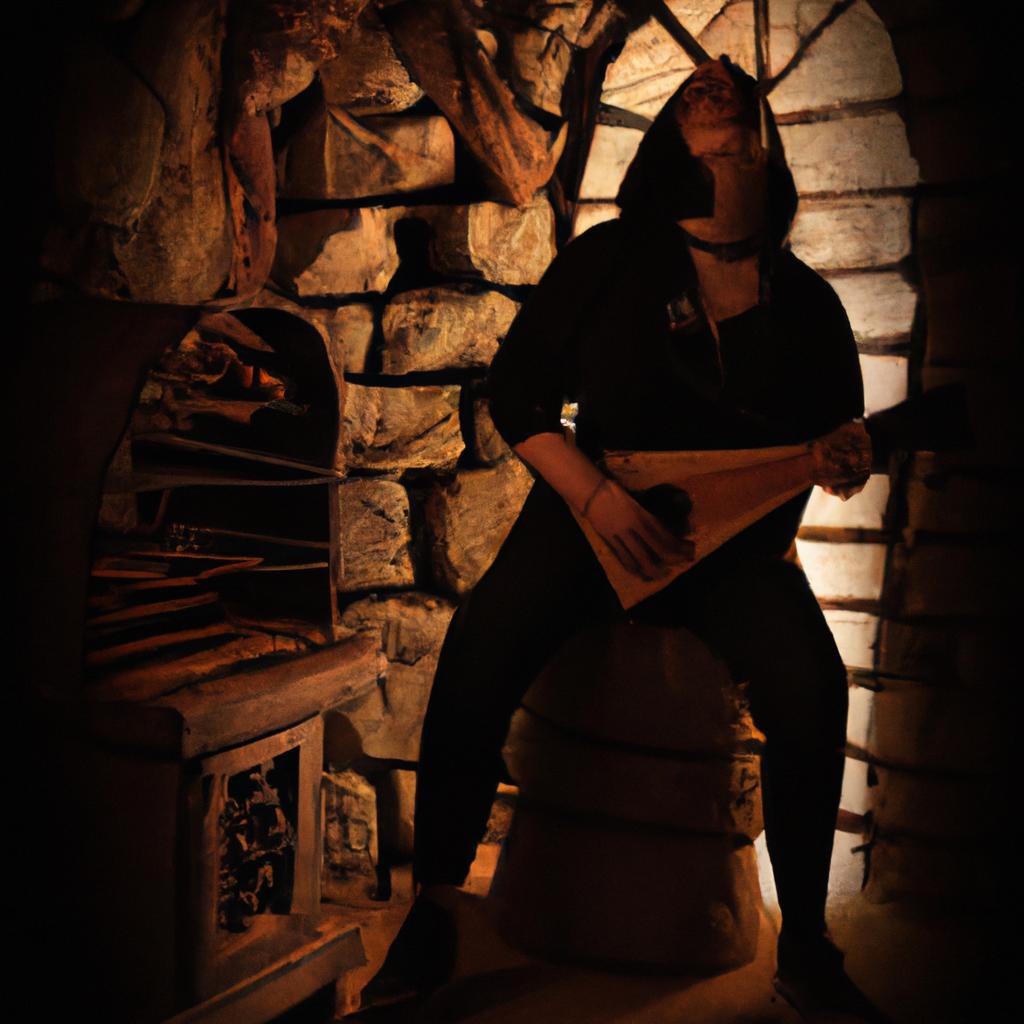The ethereal quality of Gothic music, particularly in the realm of dark ambient sounds, has captivated listeners and artists alike for decades. Defined by its atmospheric and haunting melodies, this subgenre delves into the realms of darkness, melancholy, and introspection. Through the use of electronic instruments, field recordings, and various sound manipulation techniques, dark ambient creates a sonic landscape that evokes a sense of otherworldliness and mystery.
For instance, consider the hypothetical case study of a listener stumbling upon an album titled “Nocturnal Reverie.” As they press play, they are immediately enveloped in an eerie atmosphere filled with distant whispers, echoing footsteps, and ghostly synths. The absence of traditional song structures allows their imagination to wander freely through shadowy landscapes and forgotten ruins. This captivating experience demonstrates how ethereal elements within Gothic music can transport individuals to alternate dimensions where emotions reign supreme.
Within this article, we will explore the origins of dark ambient music within the broader Gothic genre while investigating its distinct characteristics and unique production techniques. Furthermore, we will delve into the emotional impact it invokes in listeners as well as its connection to themes such as mortality, spirituality, and existentialism. By examining these aspects closely, we aim to shed light on By examining these aspects closely, we aim to shed light on the profound and introspective nature of dark ambient music, as well as its ability to evoke a range of emotions and delve into existential themes. Additionally, we will explore how artists in this genre utilize various production techniques to create their ethereal soundscapes and capture the essence of Gothic music’s haunting allure.
Throughout our exploration, we will also touch upon the influence of Gothic literature, art, and architecture on dark ambient music. The eerie atmospheres and mysterious aesthetics found within these creative mediums have long been a source of inspiration for musicians seeking to convey a sense of darkness and introspection through their compositions.
Moreover, we will discuss the role that dark ambient music plays in creating immersive experiences, whether it be through live performances or personal listening sessions. The ability of this subgenre to transport listeners to alternate dimensions or evoke deep emotions highlights its power as a form of artistic expression.
In conclusion, this article aims to provide readers with a comprehensive understanding of dark ambient music within the broader context of Gothic music. By exploring its origins, distinct characteristics, emotional impact, production techniques, and connection to existential themes, we hope to illuminate the captivating world of ethereal sounds that has enthralled listeners for decades.
The Origins of Ethereal Music
Ethereal music, characterized by its haunting and otherworldly sounds, has deep roots in the Gothic subculture. Emerging in the late 1970s as a response to the growing interest in dark and atmospheric themes, ethereal music sought to evoke an emotional response through its unique blend of ambient melodies and gothic aesthetics.
To illustrate the impact of ethereal music, let us consider the case study of Dead Can Dance, an influential band that played a pivotal role in shaping the genre. Founded by Lisa Gerrard and Brendan Perry in 1981, Dead Can Dance combined various elements such as medieval chants, classical instrumentation, and modern electronic soundscapes to create their distinctive ethereal sound. Their album “Spleen and Ideal,” released in 1985, showcased this fusion beautifully and served as a catalyst for further exploration within the genre.
The popularity of ethereal music can be attributed to several key factors:
- Atmospheric Soundscapes: Ethereal artists often employ layered textures and reverberating echoes to create rich atmospheres that transport listeners into a dreamlike state.
- Emotional Intensity: By incorporating melancholic melodies and introspective lyrics, ethereal music taps into deeply-rooted emotions like longing or nostalgia.
- Gothic Aesthetics: Drawing inspiration from Gothic literature and visual art, ethereal musicians infuse their work with dark imagery, evoking a sense of mystery and enchantment.
- Spiritual Undertones: Many practitioners of ethereal music explore spiritual themes influenced by various belief systems ranging from paganism to mysticism.
| Atmospheric Soundscapes | Emotional Intensity | Gothic Aesthetics | |
|---|---|---|---|
| Example | Layered textures | Melancholic melodies | Dark imagery |
| Effect on Audience | Evokes a sense of immersion and transcendence | Connects on an emotional level | Creates a mysterious and enchanting atmosphere |
In conclusion, ethereal music has its origins in the Gothic subculture and strives to elicit an emotional response through atmospheric soundscapes, introspective lyrics, gothic aesthetics, and spiritual undertones. In the subsequent section, we will delve into the key characteristics that define this distinctive genre.
Transitioning seamlessly from the discussion of Dead Can Dance’s influence, let us now explore the key characteristics of ethereal music.
Key Characteristics of Ethereal Music
Ethereal music, with its mesmerizing and ethereal soundscapes, has found a significant place within the realm of gothic music. Drawing inspiration from various sources, this genre creates an otherworldly atmosphere that captivates listeners. In order to understand the key characteristics of ethereal music, it is important to delve into its sonic elements and emotional impact.
One example of how ethereal music incorporates these unique features can be seen in the work of British musician Lisa Gerrard. Known for her haunting vocals and experimental compositions, Gerrard’s collaboration with Brendan Perry as part of the band Dead Can Dance exemplifies the ethereal aesthetic. Their album “Within the Realm of a Dying Sun” takes listeners on a journey through atmospheric soundscapes filled with dark ambient tones and evocative melodies.
To evoke an emotional response in the audience, several key characteristics define ethereal music:
- Ambient Soundscapes: Ethereal music often relies heavily on creating expansive and immersive sound environments. These soundscapes are built upon layers of synthesizers, drones, and reverb-laden instruments.
- Atmospheric Instrumentation: The use of unconventional instruments such as dulcimers, harpsichords, or even traditional orchestral instruments played in non-conventional ways adds to the mysterious and enchanting nature of ethereal music.
- Haunting Vocals: Often characterized by wordless singing or lyrics sung in languages unfamiliar to many listeners, ethereal vocals aim to transcend language barriers and create an emotional connection purely through their tonality.
- Dark Themes: Ethereal music frequently explores themes related to mortality, spirituality, beauty within darkness, and introspection. These thematic elements contribute to the overall mystique surrounding this genre.
| Key Characteristics | Examples |
|---|---|
| Ambient Soundscapes | Layers of synthesizers |
| Reverb-laden instruments | |
| Atmospheric | Unconventional instruments |
| Instrumentation | (dulcimers, harpsichords) |
| Traditional orchestral instruments played unconventionally | |
| Haunting Vocals | Wordless singing |
| Lyrics in unfamiliar languages | |
| Dark Themes | Mortality |
| Spirituality | |
| Beauty within darkness | |
| Introspection |
The ethereal nature of this genre not only creates a captivating listening experience but also influences other artistic mediums. In the subsequent section, we will explore how gothic literature has influenced the development and evolution of ethereal music. By examining this connection, we can gain a deeper appreciation for the rich tapestry that is woven between these two art forms, ultimately enhancing our understanding and enjoyment of both.
The Influence of Gothic Literature on Ethereal Music
Ethereal music, with its ethereal and otherworldly qualities, often finds inspiration from various sources. One notable influence on this genre is gothic literature, which has had a profound impact on the creation of dark ambient sounds. By examining the interplay between these two art forms, we can gain a deeper understanding of how gothic literature has shaped ethereal music.
To illustrate this connection, let us consider an example: “The Fall of the House of Usher” by Edgar Allan Poe. This haunting tale tells the story of a decaying mansion and its inhabitants plagued by madness and supernatural phenomena. When translated into musical form, it serves as a rich source for creating atmospheric soundscapes that capture the eerie atmosphere depicted in the story.
There are several key characteristics that emerge when exploring the influence of gothic literature on ethereal music:
- Atmosphere: Gothic literature often evokes feelings of mystery, darkness, and foreboding. Ethereal music draws upon this atmospheric quality to create immersive sonic experiences that transport listeners to shadowy realms.
- Melancholy: Both gothic literature and ethereal music tend to embrace themes of melancholy and introspection. Through haunting melodies and somber harmonies, they evoke a sense of longing and sadness in their audience.
- Symbolism: Gothic literature frequently employs symbolism to convey deeper meanings within its narratives. In a similar vein, ethereal music incorporates symbolic elements through intricate layering of instruments or electronic effects, adding depth to its compositions.
- Narrative Structure: Many works within gothic literature follow non-linear narrative structures or employ fragmented storytelling techniques. Ethereal music utilizes similar approaches by incorporating unconventional song structures or abstract sonic arrangements that challenge traditional expectations.
By delving into these shared characteristics between gothic literature and ethereal music, we uncover a captivating world where stories come alive through soundscapes full of mystery and emotion.
Transitioning seamlessly into the subsequent section, we can now explore the subgenres of ethereal music and how they further expand upon these gothic influences.
Exploring the Subgenres of Ethereal Music
Building upon the influence of gothic literature on ethereal music, this section delves into the exploration of various subgenres within the realm of ethereal music. To illustrate this point, let us consider a hypothetical case study where an artist has seamlessly blended dark ambient sounds with ethereal elements.
One prominent feature found in this unique blend is the use of eerie atmospheric textures that create a sense of otherworldliness. These captivating sonic landscapes transport listeners to hauntingly beautiful realms, evoking feelings of mystery and introspection. The combination of ethereal vocals and ominous synth layers further immerses the audience in a state of melancholic tranquility.
- Darkwave: A subgenre characterized by gloomy melodies, intense emotions, and poetic lyrics.
- Neoclassical: Combines classical orchestration with electronic elements to evoke grandeur and beauty.
- Dream pop: Known for its hazy soundscapes, dreamy vocals, and shimmering guitar effects.
- Trip hop: Often features downtempo beats infused with ethereal vocals and atmospheric samples.
Furthermore, it is essential to note how these subgenres interconnect within the larger scope of ethereal music. To provide clarity, here is a table highlighting some key characteristics:
| Subgenre | Characteristics |
|---|---|
| Darkwave | Moody melodies; introspective lyrics |
| Neoclassical | Orchestral arrangements; fusion of traditional instruments with electronic sounds |
| Dream pop | Shimmering guitars; lush atmospheres; soothing yet distant vocals |
| Trip hop | Downtempo beats; haunting vocal samples; incorporation of hip-hop elements |
By exploring these diverse subgenres and their distinctive traits, one gains a deeper appreciation for the ethereal genre as a whole. The fusion of dark ambient sounds with ethereal elements offers listeners a captivating and emotionally charged musical experience.
Transitioning into the subsequent section about notable artists in the ethereal music scene, we will now delve into the works of those who have contributed significantly to this enchanting realm.
Notable Artists in the Ethereal Music Scene
After delving into the captivating world of ethereal music, it is worth exploring its numerous subgenres that have emerged over time. These subgenres offer distinct variations in style and mood while still retaining the ethereal essence. One notable example is the subgenre known as “Dark Ambient,” which combines elements of ambient music with a hauntingly dark atmosphere.
To illustrate this further, let us consider a hypothetical case study involving an artist named Sarah. Drawing inspiration from her personal experiences with isolation and melancholy, Sarah creates mesmerizing compositions characterized by ethereal textures and unsettling soundscapes. Through her use of atmospheric synths, reverberating drones, and distant whispers, she transports listeners to a realm shrouded in darkness and mystery.
When examining the characteristics of Dark Ambient within the broader context of ethereal music, several key features become apparent:
- Mood: The prevailing mood in Dark Ambient music often evokes feelings of unease, introspection, or even dread.
- Sound Design: Artists employ various techniques such as heavy reverb, dissonant tones, and spectral sampling to create otherworldly sonic landscapes.
- Minimalism: Unlike more heavily layered genres like Shoegaze or Dream Pop, Dark Ambient tends to embrace minimalistic approaches where sparse arrangements allow for greater emphasis on each individual element.
- Visual Imagery: Dark Ambient often conjures vivid mental images reminiscent of desolate landscapes, abandoned spaces, or supernatural occurrences.
Table: Emotional Response Evoked by Dark Ambient Music
| Emotion | Description |
|---|---|
| Unease | A sense of discomfort or apprehension that lingers in the air. |
| Intrigue | Curiosity sparked by enigmatic soundscape exploration. |
| Isolation | Feelings associated with being alone in vast emptiness. |
| Enthrallment | A captivating and immersive experience that engrosses the listener. |
As we delve further into the different subgenres of ethereal music, it becomes evident that each possesses its own unique characteristics and emotional impact. The dark and haunting nature of Dark Ambient appeals to those seeking an exploration of the shadows through soundscapes that challenge conventional notions of harmony and melody.
Transitioning into the subsequent section about “The Impact of Ethereal Music on the Gothic Music Movement,” we can witness how these distinct subgenres have contributed to the evolution and diversification of gothic music as a whole. Through their atmospheric qualities, ethereal subgenres have helped shape a soundscape that resonates deeply with the ethos of gothic aesthetics, forging new paths for expression within this captivating movement.
The Impact of Ethereal Music on the Gothic Music Movement
The ethereal music genre has had a profound impact on the gothic music movement, with its dark ambient sounds captivating listeners and creating an otherworldly atmosphere. This section will explore the influence of ethereal music on gothic music, highlighting key aspects that have shaped this unique subculture.
One example showcasing the integration of ethereal elements into gothic music is the band Dead Can Dance. Their haunting melodies and mystical lyrics transport listeners to atmospheric realms filled with melancholic beauty. By incorporating elements such as Gregorian chants, tribal rhythms, and medieval instrumentation into their compositions, Dead Can Dance creates an ethereal experience that resonates deeply within the gothic community.
To fully comprehend the impact of ethereal music on the gothic music movement, it is essential to examine several key factors:
-
Atmosphere: Ethereal music sets a distinct tone through its use of ambient soundscape. The combination of layered textures, reverb-drenched vocals, and minimalistic instrumentation creates a dreamlike environment that mirrors the introspective nature often found in gothic aesthetics.
-
Emotional Resonance: The evocative qualities of ethereal music allow for emotional exploration and self-reflection among listeners. Its ethereal nature invites individuals to delve into complex emotions such as longing, loss, and solitude – themes commonly associated with both ethereal and gothic genres.
-
Mythology and Folklore: Many artists draw inspiration from mythology and folklore when composing ethereal tracks. These narratives can evoke a sense of mystery or enchantment, aligning them with the fantastical elements prevalent in gothic culture.
-
Visual Aesthetics: Ethereal musicians often incorporate visually striking imagery into their performances and album art. This attention to aesthetics complements visual elements prominent in goth subculture like elaborate costumes, dramatic makeup, and intricate set designs.
To illustrate these points further:
| Ethereal Music Characteristics | Emotional Response |
|---|---|
| Layered textures | Enthrallment |
| Reverb-drenched vocals | Serenity |
| Minimalistic instrumentation | Contemplation |
In conclusion, the ethereal music genre has played a significant role in shaping the gothic music movement. Through its atmospheric qualities, emotional resonance, incorporation of mythology and folklore, as well as attention to visual aesthetics, ethereal music provides a captivating sonic landscape that resonates deeply within the gothic subculture.
Note: The information provided is for educational purposes only and does not aim to promote or endorse any specific musical artists or genres.




